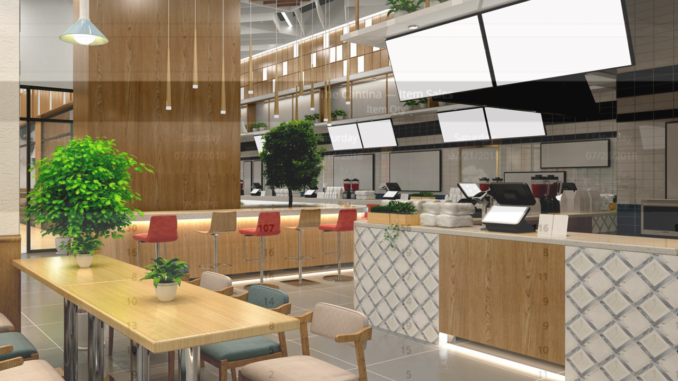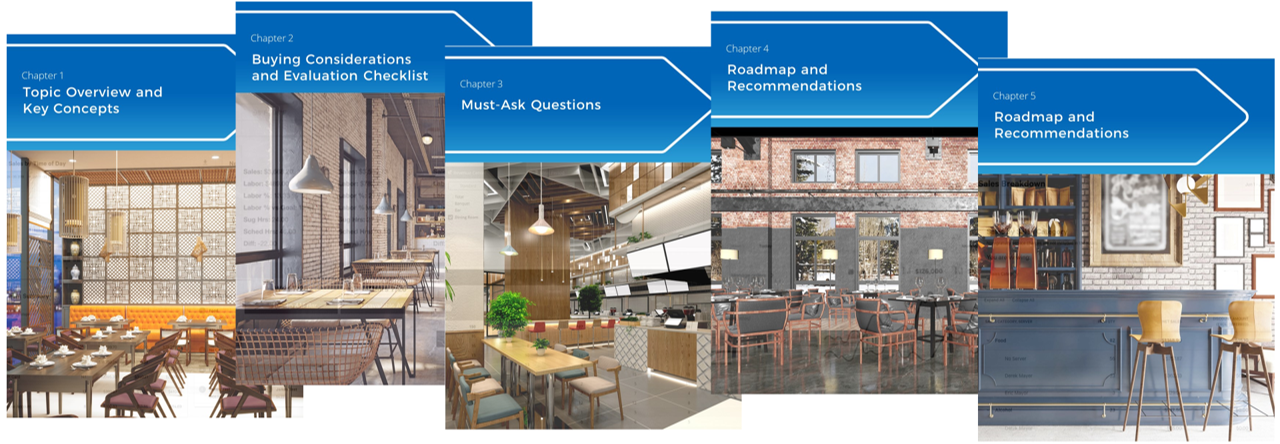
By RTN staff - 11.30.2023
When it comes to making technology investments, restaurant operators are typically driven by two primary objectives, and these objectives are even more critical in the post-pandemic era, according to the Q4-Updated Edition of “The 2023 Smart Decision Guide to Restaurant Management and POS Systems.” Published by Starfleet Research, the authoritative resource is now available for complimentary download.
The first objective is to streamline operations and optimize efficiency. In today’s highly competitive market, restaurants need to find ways to increase staff productivity, reduce waste, and improve overall process efficiency to drive cost savings and remain profitable. By leveraging the latest advancements in restaurant technology, such as advanced inventory management systems, automated order processing, and integrated workforce management tools, restaurants can achieve significant improvements in operational efficiency and resource utilization.
However, in addition to streamlining operations, enhancing the guest experience has become an equally crucial goal for restaurant operators. Customers now have higher expectations when it comes to dining experiences, and providing exceptional service and personalized interactions is key to increasing guest satisfaction and loyalty. In the era of social media and online reviews, positive guest experiences can lead to valuable word-of-mouth recommendations and positive reviews on platforms like Yelp and other popular ratings sites. These positive reviews not only attract new customers but also contribute to the overall growth and success of the restaurant.
To achieve these objectives, restaurant operators should thoroughly evaluate potential solution providers and ensure that their offerings align with these goals. They should seek out technology solutions that not only streamline operations but also prioritize guest-centric features and capabilities. These may include customer relationship management (CRM) tools, personalized marketing features, seamless online reservation systems, and integrated feedback management platforms. By selecting the right technology partner and keeping these objectives in mind, restaurants can position themselves for success in a competitive market and deliver exceptional experiences that drive revenue growth and increased customer loyalty.
Just as the buying considerations related to the purchase of a next-generation restaurant management and POS system vary to some degree depending on the needs of the restaurant, the ‘must-ask questions’ concerning specific features and functionality are also bound to depend on the restaurant’s unique situation and priorities.
The following, adopted from “The 2023 Smart Decision Guide to Restaurant Management and POS Systems,” are just a few of the questions that prospective buyers may wish to explore with solution providers during the research and evaluation process.
Is the solution flexible in terms of key areas of functionality?
Restaurant operators with specific software configuration and customization needs should ensure that any solution providers they are considering can meet these requirements. For instance, in terms of staff scheduling, some managers may prefer the option to modify or create their own scheduling templates, if available with a particular solution. Another example could be the need for a specific method of inputting menu modifiers. While most systems offer a wide range of standard dashboards and reports for operational and financial areas like sales, revenue, labor, and inventory control, which should satisfy most day-to-day performance management and analysis needs, it’s important to note that not all POS data queries and reporting requirements can be anticipated in advance or addressed with pre-built dashboards.
Prospective buyers should inquire about the extent to which customized reporting is possible and understand the process of filtering and sorting data based on specific parameters. They should also verify the solution provider’s claims by speaking with existing customers and to confirm the system’s flexibility in key areas of functionality, including custom report generation. Finally, they should inquire whether the system can accommodate the addition of new features and modules as the restaurant’s needs evolve, such as integrating with third-party applications such as a best-of-breed loyalty and rewards program.

What can be expected in terms of upgrades and updates?
Restaurant operators should inquire about the solution provider’s upgrade process and frequency of updates. A system that regularly updates its features and functionalities ensures that the restaurant stays up-to-date with industry trends and can adapt to changing customer expectations.
Does the solution allow for scalability?
Restaurant operators with future expansion plans need to ensure that any system under consideration can accommodate the growth and changing needs of the restaurant over time. Scalability refers to the system’s ability to adapt and expand as the restaurant grows. It is important to inquire about such aspects as system capacity (i.e., can the system handle increasing transaction volumes and a growing customer base without compromising performance or speed?) and whether the system can efficiently manage and consolidate operations across different restaurant locations, providing centralized control and reporting.
What type of customer support is offered?
Restaurant operators should have clear expectations when it comes to customer support and problem resolution as well as the training that may be needed to get servers and other staff up to speed on the new solution. Does the solution provider (or a certified subcontractor) offer an online or, better yet, in-person training program? Is it equipped to offer online troubleshooting and diagnostic processes and tools should technical issues arise? Are local, in-person service and support services on hand should there be an issue that can’t be handled remotely?
Knowing that problems will get resolved fully, and in a timely manner, is critical for a restaurant that needs to run with minimal interruption and in which an issue with meal ordering, or even a 30-second lag in payment processing, may be enough to erode the guest experience. More serious technology malfunctions or outages can, of course, have a very negative affect on revenue performance. Decision makers need to understand what to expect should they ever get into a situation that requires immediate attention.
What is the total cost of ownership? Are there any “hidden expenses?”
Next-generation restaurant management and POS systems, on the whole, are typically more affordable and require less upfront investment compared to their predecessors. Several factors contribute to this increased affordability,
such as simplified installation processes and reduced hardware costs compared to a decade ago. This is particularly true for mobile POS or tablet-only restaurant operations. With the growing number of cloud-based systems, POS data is stored entirely in the cloud, eliminating the need for on-premise servers.
Additionally, most cloud-based POS systems follow a subscription-based “pay as you go” model, which means no long-term contracts and no upfront capital investment for the software. These cloud solutions are designed to scale as the business grows, ensuring that costs align with the restaurant’s current needs. This aspect is especially important for smaller operations with limited budgets. It is crucial to confirm which software features, modules, and future upgrades, as well as any included hardware components, are part of the base recurring price quoted. This helps avoid any unexpected surprises in the future and ensures transparency in the pricing structure.
What return on investment (ROI) can be expected?
The return on investment (ROI) of a restaurant management and POS system can be measured in terms of cost reduction, which is primarily driven by increased staff productivity and improved resource utilization. It can also be measured in terms of revenue growth, which is influenced by enhanced guest satisfaction and, in some cases, faster table turnover times that allow for serving a larger number of guests. Additional benefits include improved financial performance through advanced inventory and labor management tools and better performance reporting capabilities.
When assessing ROI, consider the extent to which the new system can improve organizational and process efficiency across day-to-day functions related to guests, employees, and inventory. Will it enhance sales, revenue, and profitability by increasing table turnover rates and serving more guests simultaneously? Another crucial aspect of ROI is the reduction of losses, including food waste and losses associated with data entry
errors and technology integration costs with third-party hardware and software. Another key factor in making the business case for this investment is the system’s potential to enhance the overall quality of the guest experience, leading to increased customer loyalty and positive reviews. As any restaurant operator can attest, there is a direct correlation between favorable guest reviews and positive financial outcomes.
What is the solution provider’s track record of success?
As with the purchase of any business technology solution, reputation and customer satisfaction play pivotal roles in the decision-making process. No one wants to invest in and implement a restaurant management and POS system that fails to meet expectations, whether it be due to issues with stability, reliability, or unfulfilled promises. Gathering insights from existing customers of solution providers becomes an essential aspect of the purchasing decision.
Ideally, it is beneficial to seek feedback from restaurants that share similarities in terms of size, type, category, and technology infrastructure. Solution providers or consultants may be willing to provide customer references upon request. Some customers, especially those in non-competitive markets, might be open to sharing their experiences and even revealing the positive outcomes achieved through the solution, such as cost savings or improved guest satisfaction metrics like Yelp ratings. Testimonials and success stories from clients can also serve as valuable sources of information.
Does the solution ensure data security and compliance?
Ensuring data security and compliance with industry standards is of utmost importance for any restaurant management and POS system. While prospective buyers might think that all systems on the market provide the same robust measures to protect sensitive customer information and maintain compliance with relevant regulations, that would be a false assumption. For starters, the system should ensure data security and compliance using strong encryption protocols to safeguard data both in transit and at rest. Encryption ensures that sensitive information, such as payment card details, is securely transmitted and stored. It should operate on a secure network infrastructure, implementing measures like firewalls, intrusion detection systems, and regular network monitoring to detect and prevent unauthorized access and data breaches.
The system should have robust access controls to ensure that only authorized personnel can access sensitive data. It should also have secure data storage practices, ensuring that customer data is stored in encrypted and protected databases. Additionally, the system should adhere to industry best practices regarding data retention policies, deleting or anonymizing customer data when it is no longer necessary. Finally, the system should comply with industry-specific regulations, such as the Payment Card Industry Data Security Standard (PCI DSS) for handling payment card data.
Compliance with these standards ensures that the system meets the necessary security requirements and undergoes regular audits and assessments. It is important for restaurant owners to thoroughly evaluate the security features and compliance measures implemented by the POS system they choose. Additionally, they should inquire about the solution provider’s track record in data security and inquire about any certifications or audits they have undergone. By selecting a restaurant management and POS system that prioritizes data security and compliance, restaurant owners and operators can instill trust in their customers and mitigate the risk of data breaches or non-compliance with industry standards.
Are you an industry thought leader with a point of view on restaurant technology that you would like to share with our readers? If so, we invite you to review our editorial guidelines and submit your article for publishing consideration.

